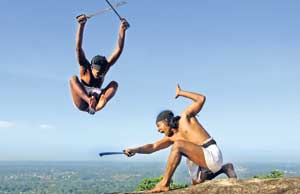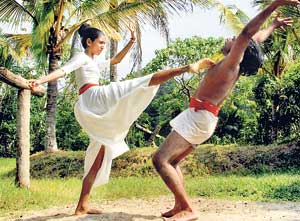What did Kataragama Mahasen of the Yaksha tribe, as legend would have it, who strode this land 25,000 years ago and showed off his prowess during a sura-aura battle, Ravana’s grandfather Pulathisi, Kuveni, Acharya Pandula, Parakrama Bahu I, Dutugemunu and the Dasa Maha Yodayas, Vijaya Bahu I, Seethawaka Rajasinghe, Leuke Disawa, Meegasteene Adikaram and Wickremasinghe Mudliyar have in common?
Some genes for sure, as the Sinhala saying goes, “Thun Sinhalema nedeyo”, but the inextricable link is angan shastraya though known in those days as a parani deshiya satan kramaya (ancient martial art).
This is what we hear while seated in a rustic wattle-and-daub hall in Koratota, Kaduwela, believed to be the only authentic angan maduwa in the country, having walked along a niyara across lush green paddyfields.
“This was the martial art that Ravana used in the battle with Rama,” explains Mahantharachchige Ajantha Perera, taking us along the misty corridors of history, while two of his golayas (disciples) in loin cloth learn the finer points of angan pora.
Twenty-six-year-old Ajantha has taken upon himself the task of nurturing and fostering this fighting technique, that had gone into disuse over time.
Considered one of the few very ancient forms of martial arts, practised long before karate and kung-fu and at a time sans guns and bombs, it was angan pora that vanquished the Portuguese at Seethawaka, explains Ajantha, adding that certain families specialised in this art form.
Having used it also against both the Dutch, and the British in the 1818 uprising triggered by Keppitipola, the British colonialists had in desperation prohibited angan pora through a Gazette notification around 1827, he says ruefully.
The weaponry used in angan pora was also banned while its practice and teaching were strictly prohibited.
If anyone broke this law, the British had warned, they would be shot at sight below the knee, says Ajantha, adding that it was then that this martial art went underground. As the British set ablaze angam madu across the country, the exponents of this technique quickly added the movements and steps to different dance forms to keep it alive.
Our elders hid this martial art in narthana krama (dance forms), says Ajantha, explaining that adi maaru krama (the different foot movements), pinum-karanam (somersaults) and pahara deem krama (modes of attack) can be seen in the koti natum, vedi natum, walas natum, sinha natum and lee-keli natum.
Why so many animal forms? In this martial art which is very close to nature, animal movements are used by the proponents, he says, adding that sathunge abhashayen gaththa shailayak.
The tools of training even now come from the environment and one of Ajantha’s golayas strengthens his arms by husking a green coconut with his bare hands.
Although earlier it was learnt by the masses at large, when the British prohibited it, the secrets were kept within the family, father passing it down to son or daughter.
There was a strict regimen when choosing the disciples. “Everyone could not learn this art,” stresses Ajantha. “Only Sinhala Buddhists were chosen after reading their horoscope. The golayas were as young as six or seven years old as their bodies were flexible and to ensure that the mind was clean.”
Both boys and girls were eligible, he says citing the cases of Navaratne Menike of Seethawaka in the 1560s and Edanduwawe Disapathiniya in the 1600s (Kandyan era).
They were also taught vedakama for kedum-bidum (broken bones and sprains) and kepum thuwala (cut injuries).
In gratitude for the support of about 18 families from Seethawaka who gave of their angan services to the country, especially in the Mulleriyawa battle, the king had presented nambu-nama (titles such as Lihinikaduwa and Suraweera) and also nindagam with a sel-lipi with the sun and the moon carved on it still standing as testimony.
This fighting technique is also mentioned in the Mahavamsa, Rajavaliya, Chulavamsa, Magasalakunu Kavi Potha, points out Ajantha, adding that several ancient temples such as the Dalada Maligawa in Kandy, the Ridi Viharaya in Kurunegala, the Vishnu Devale in Hanguranketha, the Kataragama Devale in Embekke have paintings and carvings of the different poses.
Lamenting that touches of other martial arts, such as cheena adi and even the namaskaraya from the Malayalam Malayadi have corrupted this battle form which saw the massacre of 1,600 Portuguese in 1562 on the Mulleriyawa wela, Ajantha as the Muhandiram (Principal of the angan maduwa) along with his four Pannikki Ralas vows to retain and pass on angan pora in its original form to the next generation.
The different forms of combat
This fighting technique includes angan (unarmed combat), ilangang (use of 21 different types of weapons) and maya angan (mental power) such as yantra-manthra and the gupta shastraya to scare off the opponents by creating images of two when in fact there was only one, says Ajantha who got into this martial art as a child of six, honing his skills under the expert guidance of both his grandfather and father.
There are 21 adaw (segments) which a good golaya would usually master in five years.
Targeting nila sthana (important points) in the body, an angan fighter can not only hit to make an opponent lose consciousness but also give a second blow to revive the fallen victim. “There is another blow which can bring death instantaneously,” says Ajantha, adding that a different type of blow can bring on death in six-and-a-half hours, one-and-a-half days or even three months later, while another type of blow can paralyse a person or make him dumb.
The other aspects of this martial art included rana-bera vadanaya (music) after blowing the hak gediya, followed by drum beats from the yak beraya, tammettama, daula, getaberaya and horanewa and checking out the auspicious time when going to battle, it is learnt.
The weapons used are the sword, kirichchiya (dagger), spear, keteriya (axe), kala kiringgya (knuckle duster), rita and mugura (long and short canes) and dunna (bow and arrow), he adds. |


